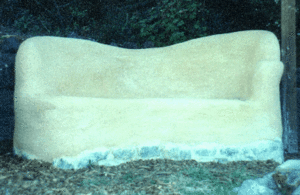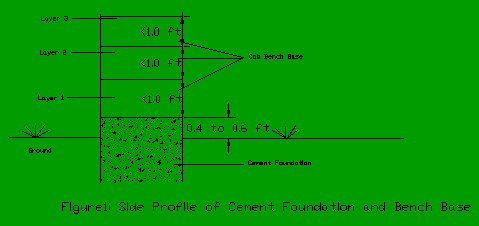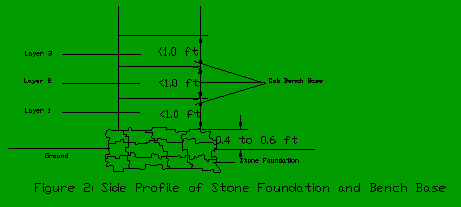
The word cob comes from an Old English root meaning "a lump or rounded mass". Cob is an ancient building material that is composed of sand, earth high in clay, straw, and water. These materials are mixed together by hands and feet to form a mud. When dry, cob is nearly as hard as concrete and has a high durability. This mixture can be used to construct benches, tables, cottages, and even houses.
This page further illustrates the procedure in which to build a cob bench. The materials needed are listed along with a step by step process for laying the foundation and erecting the bench.
Characteristics of Cob[edit | edit source]
Cost
- Depending upon availability of chosen materials, cob can be relatively inexpensive or virtually free. Sand, and straw can be purchased if no other way of obtaining them is an option. There is only a small cost related to earth high in clay and water since they can be obtained from the site itself.
Time
- Weather plays an important role in the time it takes to build with cob. The bench is built up using one foot layers of cob. The general rule is not to continue on to the next layer without allowing the previous layer to dry. In sunny warm conditions the drying process will take roughly a couple hours at the most per layer. Therefore, on a hot summer day the entire bench could be built in one day. However, in cool wet conditions, characteristic of Humboldt County, this process will take longer. It could take up to a full day for one layer to dry.
Resistance to Rain
- Cob is very resistant to weathering. If the cob is able to dry out heavy rains over a long duration will not cause the cob to wash away or weaken due to its porous nature. However, if the cob is continually saturated the structure will weaken and eventually fall apart. If this is of a concern a good way to avoid contact with rain is to construct an overhang above a bench and lay a foundation.
Durability
- Cobs high resistance to rain, strength and compactness of materials during building leads to its great durability. Structures made from cob last an extremely long time. Those built back in England in the 1400's and 1500's are still standing in nearly the exact condition as when they were first built.
Use of Natural Materials
- Cob uses only natural products that have very few adverse affects on the environment. All of the materials are non-toxic and completely recyclable meaning they can be reused.
How to Make Cob[edit | edit source]
Ingredients[edit | edit source]
Cob is made by mixing together the following ingredients: sand, earth containing clay, straw, and water. The amounts of each can vary without changing the effectiveness of the product. Therefore, numerous recipes exist [look for one on-line].
Sand and earth with clay are the main ingredients. The sand content can be as low and 50 percent and as high as 85 percent. The texture should be considered when choosing sand. A rough or jagged structure is beneficial because the grains can interlock creating a high compressive strength. The sand found at beaches is rounded and will not create this benefit. Earth containing clay on the other hand can make up anywhere from 10 to 40 percent of the total composition of cob.
The other materials needed are straw, and water. These can make up from 10 to 40 percent of the total composition. They are added to form the desired consistency. Straw is added to increase tensile strength and to bind the layers of cob together to form a strong structure.
Mixing[edit | edit source]

Materials needed:
- tarp
- shovel
- ingredients listed above
Step 1:
- Shovel the dry ingredients, sand, clay, and earth onto the tarp.
Step 2:
- Refer to Picture 1 during this step
- Working alone: Grabbing one end of the tarp, pull it up, then lay it back down.
- Working with others: Each person grab a side, one pair pull up a side while the other pair pulls down.
Step 3:

- Working alone:
- Walk to the other side and repeat the process. Continue this until ingredients are mixed well. Now you can get your hands dirty. Start mixing with your hands, feet, or shovel until thoroughly mixed. Refer to Picture 2 for an illustration.
- Working with others:
- Continue above process until mixed well. Now is when you get you get dirty. Start mixing with feet, hands, or a shovel until thoroughly mixed. Refer to Picture 2 for an illustration.
- Step 4
- Add straw and water until the consistency is that of cookie dough. A fun and easy way to do this is by using your feet, dancing in the mud. A shovel can also be used. An easy way to check the consistency is by "loafing". This is when the material folds over when the tarp is lifted and looks like a "loaf" of bread. The material should be at a level between the gooey and dry. The cob should not be so gooey is melts or so dry it falls apart.
How to Make a Cob Bench[edit | edit source]
Foundation
- There are a couple of different options to consider when choosing a foundation. The first, is plain concrete, which is quick and easy. Dig down 4 to 6 inches in the area the bench will be built to form a base for the concrete. As Figure 1 illustrates, fill the hole with the concrete and make sure it stands 4 to 6 inches off the ground to prevent water from intruding and possibly deteriorating the bench. The other option is stone with or without concrete. When choosing this option be sure to have plenty of stones of varying sizes and shapes to secure the best fit. As seen in Figure 2, stones that have two parallel flat surfaces usually work best. With this method you will want to dig down approximately 2 feet to ensure a sturdy foundation. Stack the stones on top of each other one by one, taking care in determining the best fit. Concrete can be used as a glue between the stones to hold them together more tightly.


Building Procedure
- 1) Bench Base
- In order to construct a bench the cob will need to be laid in layers on the foundation. As seen in Figures 1 and 2, the layers should be not thicker than one foot.
- Step 1:
- Transport enough cob to the foundation to make 6 inches in height, either by hand or shovel. Once this is smoothed out add the more cob to make the layer 1 foot thick.
- Step 2:
- Compress the cob with either hands or feet to heighten stability while shaping into preferred style.
- Step 3:
- Allow cob to dry, not completely, just until firm. This may take around 45 minutes.
- Step 4:
- Repeat this process until the bench base is completed.
- 2) Bench Back and Arms
- After allowing the base to dry for about 45 to 60 minutes the back and arms are ready to be started.
- Step 1:
- Transport enough cob to the base in order to create the arms and back. Remember to work in 6 inch layers.
- Step 2:
- Allow each layer to dry for 45 minutes and continue layering until completion.
- Step 3:
- While layering, shape the bench using hands to achieve desired style.
- Step 4:
- Allow entire bench to dry 3 to 4 days
Where To Find Building Materials[edit | edit source]
The materials needed for this project are easy to find and inexpensive. Sand, concrete and stones can both be found at any local rock quarry or Redi-Mix business. You want to again make sure that the sand particles have an uneven structure so they bind together easily and that the stones have 2 fairly flat parallel sides. Soil high in clay can be found usually one foot below the topsoil, while straw is normally carried by a local feed store. Water is available almost everywhere, of course.
Pictures of Cob Benches[edit | edit source]
-
The Cob Bench at CCAT
-
The Cob Bench at CCAT
-
Another Bench Style
References[edit | edit source]
- Chiras, Daniel D., The Natural House A Complete Guide to Healthy, Energy-Efficient, Environmental Homes. White River Junction: Vermont, Chelsea Green Publishing Company, 2000
- Tibbets, Joseph M., The Earthbuilders' Encyclopedia. Bosque: New Mexico, Southwest Solaradobe School, 1989.
- "The Cob Cottage Company" http://www.deatech.com/cobcottage/ (September 12, 2000)
- "Cobworks" http://www.cobworks.com/ (September 12, 2000)
- "Groundworks" http://www.cpros.com/~sequoia/ (September 12, 2000)
- "Down To Earth Building Bee" http://web.archive.org/web/20181015231040/http://www.alternatives.com:80/cob-building/ (September 28, 2000)
See also[edit | edit source]
- 4th and F St. Cob Bench
- The Making of a Cob Bench - CCAT Student Project Page
Sendog6913 17:30, 2 March 2008 (PST) Cal Poly Humboldt - CCAT


